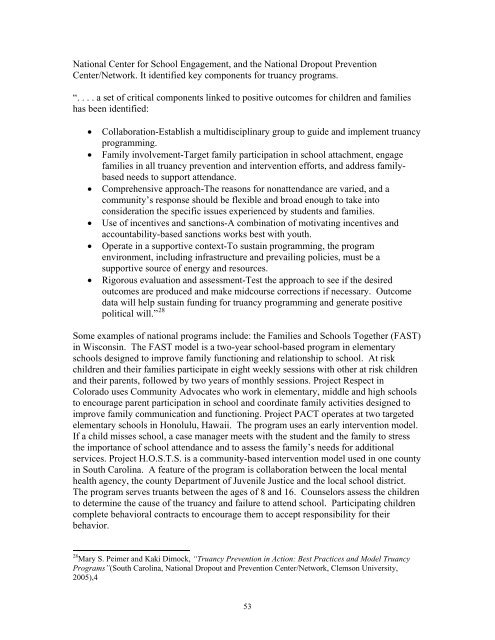FWSN-advisorybd-repo.. - The Connecticut Juvenile Justice Alliance
FWSN-advisorybd-repo.. - The Connecticut Juvenile Justice Alliance
FWSN-advisorybd-repo.. - The Connecticut Juvenile Justice Alliance
Create successful ePaper yourself
Turn your PDF publications into a flip-book with our unique Google optimized e-Paper software.
National Center for School Engagement, and the National Dropout Prevention<br />
Center/Network. It identified key components for truancy programs.<br />
“. . . . a set of critical components linked to positive outcomes for children and families<br />
has been identified:<br />
• Collaboration-Establish a multidisciplinary group to guide and implement truancy<br />
programming.<br />
• Family involvement-Target family participation in school attachment, engage<br />
families in all truancy prevention and intervention efforts, and address familybased<br />
needs to support attendance.<br />
• Comprehensive approach-<strong>The</strong> reasons for nonattendance are varied, and a<br />
community’s response should be flexible and broad enough to take into<br />
consideration the specific issues experienced by students and families.<br />
• Use of incentives and sanctions-A combination of motivating incentives and<br />
accountability-based sanctions works best with youth.<br />
• Operate in a supportive context-To sustain programming, the program<br />
environment, including infrastructure and prevailing policies, must be a<br />
supportive source of energy and resources.<br />
• Rigorous evaluation and assessment-Test the approach to see if the desired<br />
outcomes are produced and make midcourse corrections if necessary. Outcome<br />
data will help sustain funding for truancy programming and generate positive<br />
political will.” 28<br />
Some examples of national programs include: the Families and Schools Together (FAST)<br />
in Wisconsin. <strong>The</strong> FAST model is a two-year school-based program in elementary<br />
schools designed to improve family functioning and relationship to school. At risk<br />
children and their families participate in eight weekly sessions with other at risk children<br />
and their parents, followed by two years of monthly sessions. Project Respect in<br />
Colorado uses Community Advocates who work in elementary, middle and high schools<br />
to encourage parent participation in school and coordinate family activities designed to<br />
improve family communication and functioning. Project PACT operates at two targeted<br />
elementary schools in Honolulu, Hawaii. <strong>The</strong> program uses an early intervention model.<br />
If a child misses school, a case manager meets with the student and the family to stress<br />
the importance of school attendance and to assess the family’s needs for additional<br />
services. Project H.O.S.T.S. is a community-based intervention model used in one county<br />
in South Carolina. A feature of the program is collaboration between the local mental<br />
health agency, the county Department of <strong>Juvenile</strong> <strong>Justice</strong> and the local school district.<br />
<strong>The</strong> program serves truants between the ages of 8 and 16. Counselors assess the children<br />
to determine the cause of the truancy and failure to attend school. Participating children<br />
complete behavioral contracts to encourage them to accept responsibility for their<br />
behavior.<br />
28 Mary S. Peimer and Kaki Dimock, “Truancy Prevention in Action: Best Practices and Model Truancy<br />
Programs”(South Carolina, National Dropout and Prevention Center/Network, Clemson University,<br />
2005),4<br />
53
















